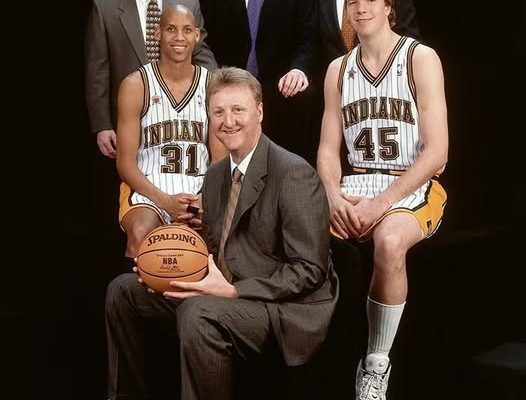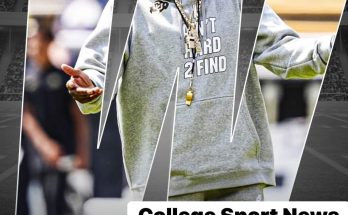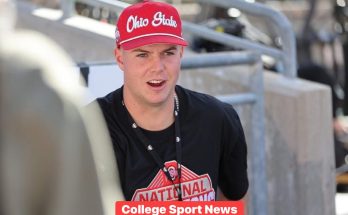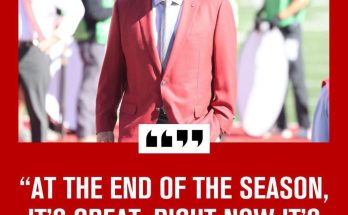This image captures a powerful and iconic moment tied to the Indiana Pacers in the late 1990s, a period marked by intense competition, rising stars, and a franchise striving to carve out its identity in the NBA landscape. At the heart of this scene stands Larry Bird, one of basketball’s greatest legends, positioned at the center holding a basketball. The image likely dates to around the 1998 NBA All-Star Game, a significant event that not only celebrated the league’s top talent but also symbolized a transitional era in basketball history. Larry Bird’s presence in this snapshot is particularly poignant because it reflects a time when he had stepped off the court as a player and transitioned into a key executive role, shaping the Pacers’ trajectory with his deep understanding of the game and unwavering competitive spirit.
Larry Bird’s association with the Indiana Pacers during the late 1990s was a defining chapter in his post-playing career. After retiring as a player in 1992, Bird was drawn back into the game with the Pacers, initially as a special advisor and later ascending to the role of head coach in 1997. His coaching tenure, although relatively brief, was impactful and demonstrated his deep basketball acumen and leadership. The 1998 NBA All-Star Game period was thus not just a moment of celebration but a marker of Bird’s evolving influence on the sport, especially with a team that had long admired his legendary playing days with the Boston Celtics.
The late 1990s were a critical time for the Indiana Pacers. The franchise was shedding its underdog label and striving to compete at the highest levels. Under Bird’s leadership, the Pacers made significant strides, transforming from perennial playoff participants to legitimate championship contenders. Bird’s basketball IQ, cultivated from years of playing at the highest level, enabled him to connect with his players in a way that few coaches could. He instilled discipline, strategic thinking, and a winner’s mentality into the squad. This image, featuring Bird at the center holding the ball, can be seen as a metaphor for his central role in orchestrating the Pacers’ rise during this period.
The Pacers of the late 1990s were led by a remarkable core of players, many of whom would become household names. Reggie Miller, the team’s iconic sharpshooter and a symbol of toughness and precision, was the on-court leader whose clutch performances defined Indiana basketball. Players like Rik Smits, the towering Dutch center known as “The Dunking Dutchman,” and veterans such as Dale Davis and Antonio Davis provided toughness and inside presence. Meanwhile, emerging talents and role players contributed to a balanced team capable of competing with the best in the league. Larry Bird’s guidance helped meld these diverse talents into a cohesive unit.
Bird’s impact extended beyond his tactical knowledge. His presence elevated the entire franchise’s stature. When Bird took over coaching duties in 1997, the Pacers were viewed as solid but not elite. His leadership galvanized the team, pushing them to reach new heights, culminating in the 1998-1999 season when the Pacers advanced to the Eastern Conference Finals. Although they fell short of the NBA Finals, the foundation Bird laid during this period was critical in setting the stage for the franchise’s future successes, including the memorable 2000 NBA Finals appearance.
The 1998 NBA All-Star Game itself was emblematic of an era undergoing transition. It was one of the final major basketball events before the turn of the millennium, a period when legends like Bird had stepped away from playing but remained deeply influential. The All-Star Game brought together the best talent from across the league and was a showcase not only for players but also for coaches and executives shaping the future. Larry Bird’s involvement at this juncture underscored his ongoing importance to the league and the Pacers organization.
In this image, Larry Bird holding the basketball symbolizes more than just a moment frozen in time; it encapsulates his continuing contribution to the sport. From his days as a player who redefined the forward position with his shooting, passing, and fierce competitiveness, to a coach and executive who applied those lessons off the court, Bird remained central to basketball’s evolution. The late 1990s Pacers, under his stewardship, embraced a style of play that combined grit, teamwork, and precision—hallmarks of Bird’s basketball philosophy.
Moreover, this era for the Pacers was also about battling the dominance of other Eastern Conference powerhouses, most notably the Chicago Bulls led by Michael Jordan, who had returned from his first retirement and was reshaping the competitive landscape. The Pacers, fueled by Bird’s coaching and Miller’s heroics, were often the team closest to challenging the Bulls’ supremacy. This competitive fire forged some of the most intense and memorable playoff battles of the late 1990s, further embedding the Pacers into NBA lore.
Bird’s role in this period also helped to elevate the Pacers’ identity beyond just a mid-market team. His name alone attracted attention and respect, and his basketball credibility helped Indiana recruit talent and retain key players. His strategic mind and calm demeanor contrasted with the intense pressure of playoff basketball, providing stability and confidence to a franchise on the rise.
This image of Larry Bird holding the basketball at the 1998 NBA All-Star Game can also be viewed in the context of his broader legacy in the NBA. Bird is often remembered as one of the greatest players in NBA history, a three-time MVP, and a key figure in the storied Celtics-Lakers rivalry that defined the 1980s. Yet his legacy is also deeply tied to his post-playing career achievements. His time with the Pacers foreshadowed a successful front-office career that would later include building championship contenders in the 2010s as the team’s President of Basketball Operations. The seeds of that success were planted during these late 1990s years when Bird was proving his value in leadership and talent evaluation.
In essence, this image captures a moment where past greatness meets future promise. Larry Bird, once the electrifying player with a sharpshooter’s touch and relentless work ethic, is now the guiding force behind the Pacers, holding the basketball as a symbol of control, vision, and leadership. The late 1990s were a time of change for the NBA and for Indiana basketball—a time when Bird’s influence helped shape not just the team’s strategies but also its culture and aspirations.
The impact of Bird’s coaching tenure and his broader involvement with the Pacers during this period cannot be overstated. His ability to inspire players and orchestrate game plans was a continuation of his relentless competitiveness. Under his watch, the Pacers became one of the most respected and feared teams in the league, regularly challenging the best teams and setting the stage for future accomplishments. The 1998 All-Star period is emblematic of this transition, capturing Bird at a pivotal moment when he was redefining his role in basketball, moving from legend on the court to legend behind the scenes.
This era also witnessed the rise of Reggie Miller as the face of the franchise, with Bird’s mentorship playing a crucial role. Miller’s sharpshooting and fearless attitude echoed Bird’s own playing style, and their relationship was built on mutual respect and a shared vision of competitiveness. Bird’s insights into the game and his ability to convey strategy helped Miller and the Pacers maximize their potential.



